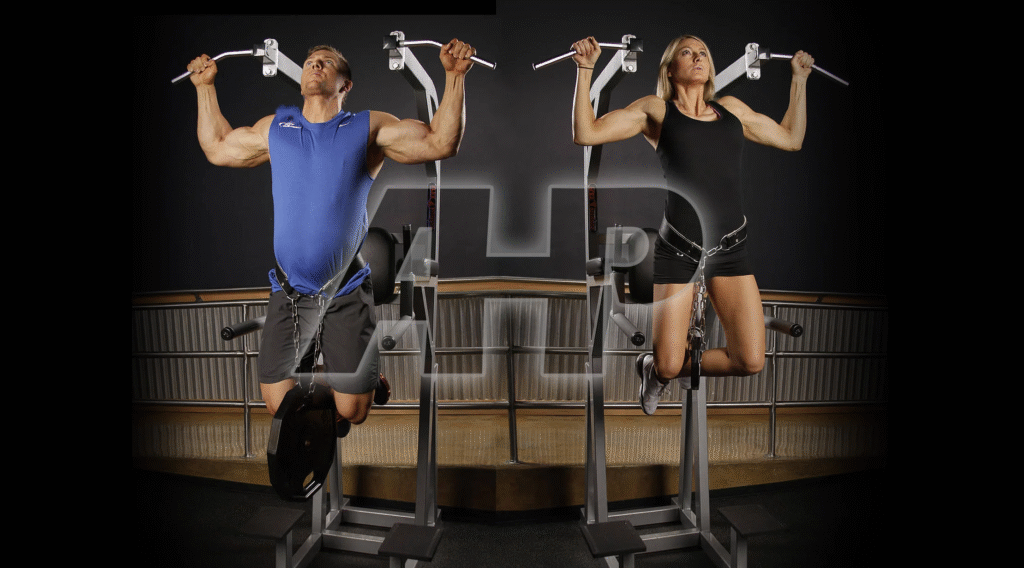Introduction
Pull-Up is one of the most challenging yet rewarding bodyweight exercises you can master. It builds strength in your back, shoulders, arms, and core while improving overall upper body stability.
But for many beginners — and even experienced gym-goers — the first pull-up feels almost impossible. If you’ve ever hung from a pull-up bar and felt like gravity is winning, you’re not alone.
The good news? With the right training approach, anyone can work their way up to doing their first pull-up. This guide will show you exactly where to start if you can’t do a pull-up yet, with step-by-step progressions, tips, and common mistakes to avoid.
1. Why Pull-Ups Are So Hard

Before you start training, it’s important to understand why pull-ups can be difficult:
- Multiple Muscle Groups Involved: Pull-ups require simultaneous engagement of your lats, biceps, shoulders, traps, forearms, and core.
- Relative Strength: You’re lifting your entire body weight, which demands a strong strength-to-weight ratio.
- Grip Strength Limitation: Many beginners fail not because of back weakness, but because their grip gives out first.
- Lack of Technique: Without proper body positioning, even strong individuals may struggle.
2. The Muscles Used in a Pull-Up
Knowing which muscles you’re targeting will help you train more effectively.
| Muscle Group | Role in Pull-Up |
|---|---|
| Latissimus Dorsi (Lats) | Primary pulling muscle |
| Biceps | Assist in elbow flexion |
| Trapezius & Rhomboids | Stabilize shoulder blades |
| Forearms & Grip Muscles | Maintain hold on the bar |
| Core Muscles | Prevent swinging and keep body tight |
3. Assess Your Current Strength
Before jumping into training, test where you are:
- Can you hang from a bar for 20–30 seconds?
- Can you do an inverted row with proper form?
- How many push-ups can you do?
These basic tests will help you gauge how much foundational strength you already have.
4. Step-by-Step Progressions to Your First Pull-Up
Step 1: Improve Grip Strength
A strong grip is essential.
Exercises to try:
- Dead hangs: Hang from a bar for 20–60 seconds.
- Farmer’s carries: Walk while holding heavy dumbbells.
- Towel hangs: Hang from a bar with towels for extra grip challenge.
Step 2: Strengthen Your Back and Arms
You need to target the main pull-up muscles without doing a full pull-up yet.
Key exercises:
- Lat Pulldowns (mimics pull-up movement but with adjustable weight)
- Seated Rows (builds mid-back strength)
- Bicep Curls (supports elbow pulling action)
Step 3: Master the Inverted Row
The inverted row is a beginner-friendly pulling exercise.
How to do it:
- Lie under a bar or suspension trainer.
- Pull your chest to the bar while keeping your body straight.
- Start with knees bent, progress to straight legs.
Step 4: Try Negative Pull-Ups
Negative reps build strength in the lowering phase.
Steps:
- Use a bench or jump to the top pull-up position.
- Slowly lower yourself down over 3–5 seconds.
- Perform 4–6 reps per set.
Step 5: Use Resistance Bands
A resistance band helps reduce the weight you’re pulling.
Tips:
- Loop the band over the bar and place one foot or knee inside.
- Perform pull-ups with controlled movement.
- Gradually switch to a lighter band over time.
Step 6: Engage Your Core
Your core keeps you stable during the pull-up.
Exercises for a stronger core:
- Planks (front and side)
- Hollow body holds
- Hanging knee raises
Step 7: Practice Assisted Pull-Ups
If you have access to an assisted pull-up machine, use it to mimic the motion while reducing load.
5. Sample Beginner Pull-Up Training Plan
Here’s a weekly plan to help you progress:
| Day | Exercise | Sets | Reps |
|---|---|---|---|
| Mon | Lat Pulldown | 3 | 10–12 |
| Negative Pull-Ups | 3 | 4–6 | |
| Plank | 3 | 30 sec | |
| Wed | Inverted Rows | 3 | 8–10 |
| Bicep Curls | 3 | 10–12 | |
| Dead Hangs | 3 | 20–30 sec | |
| Fri | Resistance Band Pull-Ups | 3 | 6–8 |
| Hanging Knee Raises | 3 | 10 | |
| Farmer’s Carries | 3 | 30 sec walk |
6. Common Mistakes to Avoid
- Swinging or kipping unintentionally (reduces effectiveness for strict pull-ups)
- Neglecting grip strength training
- Training only pull-ups instead of supporting exercises
- Not resting enough — muscles need recovery to grow
7. How Long Will It Take to Do Your First Pull-Up?
The timeline varies based on your starting strength, weight, and training consistency.
For most beginners training 2–3 times a week:
- 4–8 weeks for those already close to the goal
- 3–6 months for complete beginners
8. Tips to Stay Motivated
- Track your progress (reps, hang time, band resistance)
- Celebrate small wins (first 10-second dead hang, first unassisted rep)
- Train with a partner for accountability
- Mix in other fun upper-body exercises to avoid burnout
Conclusion
If you can’t do a pull-up yet, the key is to break the movement into manageable steps, build foundational strength, and progress gradually. By working on grip, back, arm, and core strength while practicing assisted variations, you’ll eventually be able to pull yourself up to that bar with confidence.
Remember: every rep, hang, and row is a step closer to your goal. Stay consistent, and your first pull-up will happen sooner than you think.
